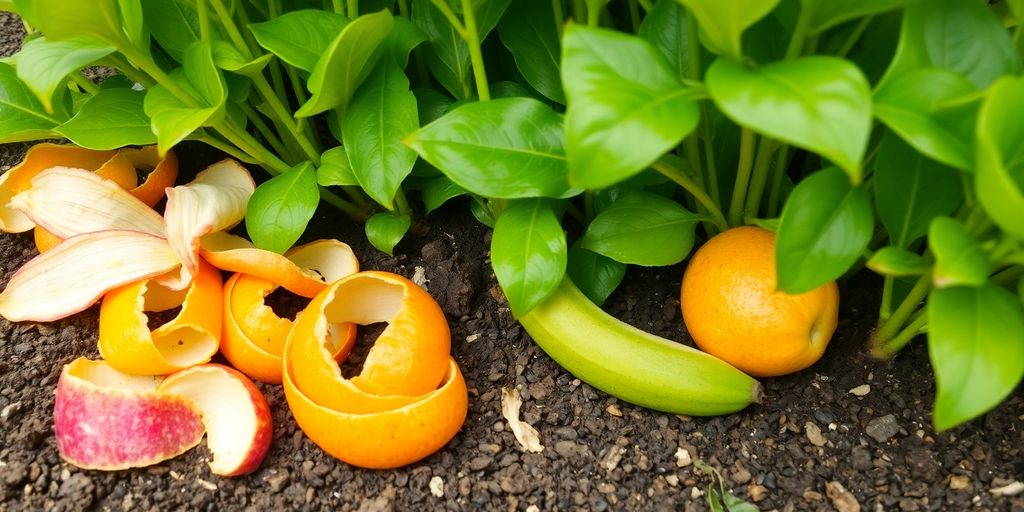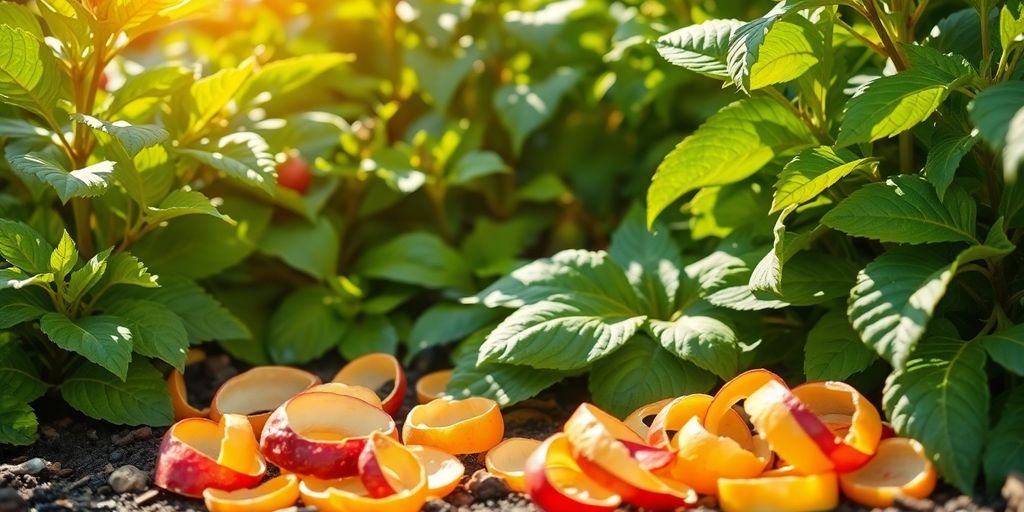If you’re looking to boost your garden’s health without breaking the bank, using fruit peels as a natural fertilizer is a fantastic option. Not only do these peels provide essential nutrients to your plants, but they also help improve soil quality.
In this guide, we’ll explore the benefits of fruit peels, practical ways to use them, and tips to make the most out of your gardening efforts. Let’s get started on how to use fruit peels as natural fertilizer for plants!
- Fruit peels are rich in nutrients like potassium and phosphorus, which are great for plant growth.
- You can compost fruit peels or apply them directly to the soil for maximum benefit.
- Mixing fruit peels with other organic materials can enhance their effectiveness as fertilizers.
Understanding the benefits of fruit peels as fertilizer

Okay, so you’re probably wondering why I’m so hyped about fruit peels. Well, let me tell you, these things are like little treasure chests for your garden. I used to just toss ‘em, but now? They’re gold, Jerry, gold!
Nutrient content of common fruit peels
Fruit peels aren’t just waste; they’re packed with nutrients that plants love. We’re talking potassium, phosphorus, nitrogen, and a bunch of micronutrients. It’s like a multivitamin for your soil! Here’s a quick rundown:
- Banana peels: Super high in potassium, which is great for flowering and fruiting plants. I noticed a real difference with my tomatoes after using banana peel fertilizer.
- Orange peels: Good source of nitrogen, which helps with leafy growth. Plus, they add acidity to the soil, which some plants dig.
- Apple peels: Contain phosphorus, which is important for root development. I throw these in when planting seedlings to give them a boost.
How fruit peels improve soil health
It’s not just about the nutrients, though. Fruit peels also do wonders for the overall health of your soil. They add organic matter, which improves soil structure, drainage, and water retention. Think of it like giving your soil a fluffy, absorbent hug. Plus, as the peels decompose, they feed the beneficial microbes in the soil, creating a thriving ecosystem that supports plant growth. It’s a win-win, ya know?
Practical methods for using fruit peels in your garden
Composting fruit peels effectively
Okay, so composting fruit peels is easier than you might think. I’ve been doing it for a while now, and let me tell you, it makes a difference. Basically, you’ve got two main ways to go about it: the traditional compost pile or vermicomposting (using worms!).
- Traditional Composting: Layer your fruit peels with “brown” materials like dried leaves, cardboard, and newspaper. Aim for a good mix of “green” (fruit peels) and “brown” stuff. Keep it moist, like a wrung-out sponge, and turn the pile every so often to aerate it. This helps it break down faster. Avoid adding meat or dairy – trust me, you don’t want the smell or the pests.
- Vermicomposting: This is where worms do the work! Red wigglers are the best for this. You’ll need a worm bin, which you can buy or build. Feed the worms your fruit peels (and other kitchen scraps), and they’ll turn it into amazing compost. It’s kinda cool to watch, actually.
Direct application techniques for fruit peels
If you’re feeling a bit lazy (hey, we all have those days!), you can skip the whole composting process and apply fruit peels directly to your garden. Here are a few ways I’ve tried:
- Chopped and Sprinkled: Chop the peels into small pieces and sprinkle them around your plants. Work them into the soil a bit. This is a good way to give your plants a quick boost of nutrients.
- Buried Treasure: Dig small holes near your plants and bury the peels. This is especially good for plants that are heavy feeders, like tomatoes. Just make sure you don’t bury them too close to the roots.
- Fruit Peel Tea: Soak fruit peels in water for a few days, then use the water to water your plants. This is a great way to get the nutrients to your plants quickly. Plus, it’s super easy.
Tips for maximizing the effectiveness of fruit peel fertilizers
To really get the most out of your fruit peel fertilizer, here are a few things I’ve learned along the way:
- Chop ‘em up: The smaller the pieces, the faster they’ll break down. I usually give mine a good chop in the food processor before adding them to the compost or garden.
- Mix it up: Don’t just use fruit peels. Combine them with other organic materials like coffee grounds, eggshells, and vegetable scraps. This will give your plants a wider range of nutrients.
- Don’t overdo it: Too much of a good thing can be bad. Don’t overload your soil with fruit peels. A little goes a long way. And always bury them well to avoid attracting pests. I learned that the hard way one summer – let’s just say the raccoons had a field day!
Tips for maximizing the effectiveness of fruit peel fertilizers

Combining fruit peels with other organic materials
Alright, so you’re using fruit peels – that’s awesome! But let me tell you, the real magic happens when you mix them with other stuff. Think of it like making a killer smoothie; you wouldn’t just throw in one ingredient, right? Same deal here. I’ve found that combining fruit peels with other organic materials really kicks things up a notch. Here’s what I usually do:
- Compost Pile Power-Up: Toss those peels into your compost bin along with leaves, grass clippings, and veggie scraps. The variety helps create a more balanced and nutrient-rich compost. I aim for a good mix of “greens” (like peels) and “browns” (like dried leaves). It’s all about that carbon-to-nitrogen ratio, ya know?
- Worm Bin Wonders: If you’re into vermicomposting (worm composting), fruit peels are gold! Worms love ‘em, and they help create some seriously amazing worm castings. Just don’t overdo it with citrus peels, as too much acidity isn’t great for the worms.
- Liquid Gold: Ever tried making a “compost tea”? It’s easier than it sounds. Basically, you soak your compost (including fruit peels) in water, and then use the strained liquid to water your plants. It’s like giving them a nutrient-packed drink!
Avoiding common mistakes when using fruit peels
Okay, so using fruit peels is pretty straightforward, but there are a few things I’ve learned the hard way. Trust me, avoiding these mistakes will save you a lot of headaches (and maybe some stinky situations!).
- Don’t go overboard with citrus: Citrus peels are great, but they’re acidic. Too much can throw off your soil’s pH balance, which some plants won’t appreciate. I usually mix them in moderation with other types of peels.
- Chop ‘em up!: Big chunks of peel take forever to break down. I always give them a quick chop before adding them to the compost or soil. It speeds things up and makes it easier for the microbes to do their thing.
- Pest patrol: Fruit peels can attract unwanted visitors like fruit flies. To avoid this, bury them well in your compost or soil. And if you’re making a liquid fertilizer, keep it covered to keep those little buggers out.
- Wash those peels!: You don’t want any pesticides or chemicals ending up in your garden. Give those peels a good rinse before using them. Better safe than sorry, right?
Wrapping It Up: Embrace the Power of Fruit Peels
So, there you have it! Using fruit peels as natural fertilizer is not just easy, but it’s also a great way to give your plants the nutrients they crave. By recycling what you might normally toss in the trash, you’re not only helping your garden thrive but also doing your part for the environment.
Whether you’re tossing banana peels into your compost or using citrus peels to keep pests away, every little bit helps.
So, why not give it a shot? Your plants will thank you with vibrant growth and bountiful harvests. Happy gardening!
Frequently Asked Questions
Can I use any fruit peels in my garden?
Yes, most fruit peels are great for your garden! Banana peels, citrus peels, and apple peels are popular choices. Just make sure to chop them up to help them break down faster.
How do I apply fruit peels to my plants?
You can add fruit peels directly to the soil or mix them into your compost pile. If you use them in compost, they’ll break down and create rich fertilizer for your plants.
Are there any fruit peels I should avoid?
Yes, avoid using peels from fruits that are treated with pesticides or chemicals. Also, steer clear of peels from fruits that can attract pests, like overly sweet ones.
